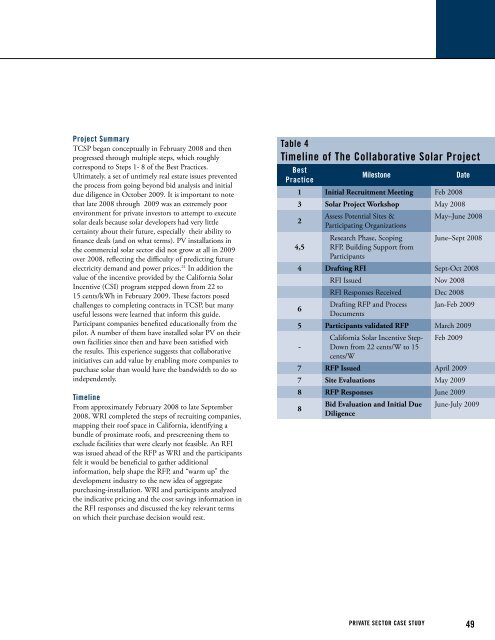PURCHASING POWER - World Resources Institute
PURCHASING POWER - World Resources Institute
PURCHASING POWER - World Resources Institute
Create successful ePaper yourself
Turn your PDF publications into a flip-book with our unique Google optimized e-Paper software.
Project Summary<br />
TCSP began conceptually in February 2008 and then<br />
progressed through multiple steps, which roughly<br />
correspond to Steps 1- 8 of the Best Practices.<br />
Ultimately, a set of untimely real estate issues prevented<br />
the process from going beyond bid analysis and initial<br />
due diligence in October 2009. It is important to note<br />
that late 2008 through 2009 was an extremely poor<br />
environment for private investors to attempt to execute<br />
solar deals because solar developers had very little<br />
certainty about their future, especially their ability to<br />
finance deals (and on what terms). PV installations in<br />
the commercial solar sector did not grow at all in 2009<br />
over 2008, reflecting the difficulty of predicting future<br />
electricity demand and power prices. 21 In addition the<br />
value of the incentive provided by the California Solar<br />
Incentive (CSI) program stepped down from 22 to<br />
15 cents/kWh in February 2009. These factors posed<br />
challenges to completing contracts in TCSP, but many<br />
useful lessons were learned that inform this guide.<br />
Participant companies benefited educationally from the<br />
pilot. A number of them have installed solar PV on their<br />
own facilities since then and have been satisfied with<br />
the results. This experience suggests that collaborative<br />
initiatives can add value by enabling more companies to<br />
purchase solar than would have the bandwidth to do so<br />
independently.<br />
Timeline<br />
From approximately February 2008 to late September<br />
2008, WRI completed the steps of recruiting companies,<br />
mapping their roof space in California, identifying a<br />
bundle of proximate roofs, and prescreening them to<br />
exclude facilities that were clearly not feasible. An RFI<br />
was issued ahead of the RFP as WRI and the participants<br />
felt it would be beneficial to gather additional<br />
information, help shape the RFP, and “warm up” the<br />
development industry to the new idea of aggregate<br />
purchasing-installation. WRI and participants analyzed<br />
the indicative pricing and the cost savings information in<br />
the RFI responses and discussed the key relevant terms<br />
on which their purchase decision would rest.<br />
Table 4<br />
Timeline of The Collaborative Solar Project<br />
Best<br />
Practice<br />
Milestone<br />
Date<br />
1 Initial Recruitment Meeting Feb 2008<br />
3 Solar Project Workshop May 2008<br />
2<br />
Assess Potential Sites &<br />
May–June 2008<br />
Participating Organizations<br />
Research Phase, Scoping June–Sept 2008<br />
4,5 RFP, Building Support from<br />
Participants<br />
4 Drafting RFI Sept-Oct 2008<br />
RFI Issued Nov 2008<br />
RFI Responses Received Dec 2008<br />
6<br />
Drafting RFP and Process Jan-Feb 2009<br />
Documents<br />
5 Participants validated RFP March 2009<br />
California Solar Incentive Step- Feb 2009<br />
- Down from 22 cents/W to 15<br />
cents/W<br />
7 RFP Issued April 2009<br />
7 Site Evaluations May 2009<br />
8 RFP Responses June 2009<br />
8<br />
Bid Evaluation and Initial Due June-July 2009<br />
Diligence<br />
private sector case study<br />
49

















